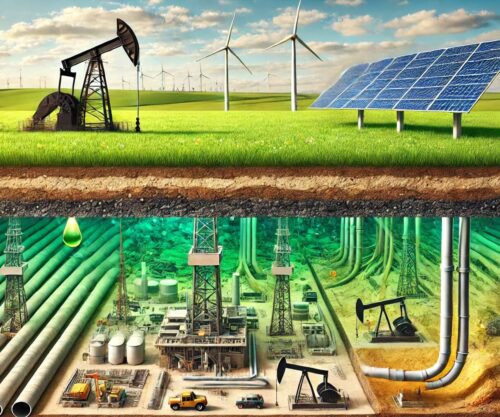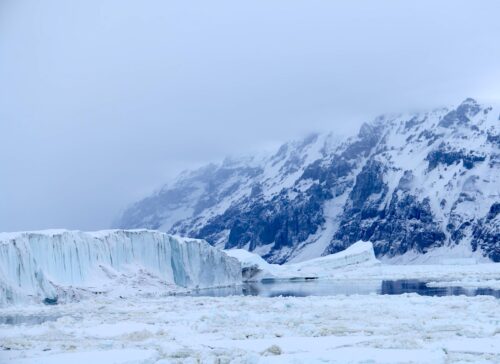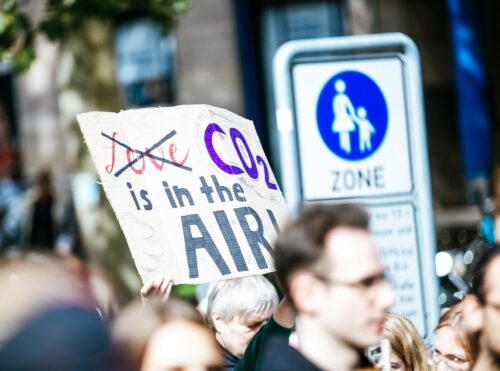 Over the last 10 years, the cost of solar panels and wind turbines declined so significantly, and were scaled-up so quickly, that many people came to believe that a transition to renewables, as proposed by advocates of a Green New Deal, was all but inevitable.
Over the last 10 years, the cost of solar panels and wind turbines declined so significantly, and were scaled-up so quickly, that many people came to believe that a transition to renewables, as proposed by advocates of a Green New Deal, was all but inevitable.
We already have all the technologies we need to transition to 100% renewables, leading scientists and scholars told The New Yorker’s John Cassidy. “The only reason not to do it is political inertia and the influence of the existing fossil-fuel industry,” one said.
And yet grassroots opposition to solar and wind farms is growing and has nothing to do with fossil fuel interests, climate skepticism, or bureaucratic inertia. Indeed, most of it is motivated by concerns over the impact of renewables on the natural environment and quality-of-life.
The largest county in California, San Bernardino, last week banned the building of any larger solar and wind farms over the opposition of renewable energy lobbyists and labor unions. They did so on behalf of conservationists and locals seeking to protect fragile desert ecosystems.
In January, policymakers in Spotsylvania, Virginia voted to block the building of a solar farm, which would be the largest in America east of the Rocky Mountains, after local residents organized themselves in opposition out of concern over the impact on the environment, property values, and electricity prices.
And in the midwest, it is birders and conservationists, not climate skeptics and fossil fuel interests, who are organizing to block a massive new wind farm proposed for Lake Erie, a biodiversity hotspot for migratory birds and bats.
It’s not the first time scientists and conservationists have opposed renewables. Over the last decade, both groups have turned against two of the largest sources of renewable energies: biofuels, including corn ethanol, and biomass. Both had been long touted, like solar and wind, as climate solutions.
It all raises the question: with biofuels and biomass no longer accepted as “green,” is it only a matter of time before environmentalists similarly reject other forms of renewable energy, including solar and wind?

Farming Energy
Solar and wind advocates say their technologies are fundamentally different from burning plant matter. To some extent they are correct. The best-available science today shows that solar farms produce one-tenth the carbon emissions as biomass power plants.
And where biomass and biofuels are farmed, solar panels and wind turbines are manufactured in factories. Where biomass and biofuels produce heat that powers engines and turns turbines, solar panels convert sunlight into electrons, and the wind turns blades whose spinning generates electricity.
But these arguments are suspiciously similar to the ones made for decades by advocates of ethanol and biomass. They claimed their technologies were good for the environment because the emissions they produced when combusted would be reabsorbed by the vast plantations of corn, palm, and forest products.
And biomass and biofuel makers have long claimed their products are high tech, requiring processing in factories to turn wood into pellets and distill corn into ethanol.
Part of the problem is that turning grasslands and forests into farms releases huge amounts of carbon held in the plant matter and soil. And since the amount of land for agriculture is finite, the expansion of biofuels and biomass meant converting more of the Earth for farming
The same is often true for building solar and wind farms. The building of that massive solar farm in Virginia required clear-cutting a working tree farm. The role those trees played in sequestering carbon dioxide would be lost with the building of the solar farm.
Solar and wind advocates correctly note that the carbon emissions avoided by using electricity from solar and wind farms rather than from coal or natural gas is greater than the loss of carbon sequestered by the soil, trees, and other woody biomass.
But the problem conservationists had with ethanol and biomass was never simply about carbon emissions or air pollution.
Indeed, the scientific paper revealing just how terrible biofuels are for the environment was made by a conservation attorney worried about the impact of biofuels expansion on fragile ecosystems.
For as much as people hate “Big Oil,” it turns out that petroleum is incredibly land-efficient.
Even much-hyped biofuels like sugarcane require six times more land to produce the same amount of energy as petroleum. The least efficient biofuel, made from soybeans, requires 20 times more land as petroleum.
Renewable energy developers, whether of ethanol, biomass, or solar and wind, argue that farms are going to be farmed no matter what, and so we might as well use them to produce alternatives to fossil fuels.
But that claim ignores the fact that one of the greatest drivers of land conservation has been the radically improved efficiency of farming, and reduced use of land.
In the rich nations of Europe and North America, much of the land used for farming in the 19th Century became economically worthless and gradually returned to being grasslands and forests.
Most conservationists today recognize we need to grow more food on less land in order to take pressure off of ecological hotspots like the Amazon forest and lowland rainforests of southeast Asia, as well as to reduce carbon emissions, one-quarter of which come from agriculture.
Even when building solar and wind farms doesn’t require clear-cutting forests they still have massive ecological impacts. Wind turbines are one of the greatest threats to important bird species and bats.
And while building solar farms in the desert doesn’t require clear-cutting forests, they still have massive impacts on landscapes.
For example, developers of the Ivanpah solar farm in California’s Mojave desert had to hire biologists to extract threatened desert tortoises from their burrows, put them on the back of pickup trucks, transport them, and cage them in pens where many ended up dying.
Like biomass and biofuels, solar and wind energies require covering a huge amount of land with solar panels and wind turbines. Even in sunny California, 450 times more land is required to generate the same amount of electricity from solar as from nuclear.
“Renewable-energy projects aren’t the only ones facing resistance,” noted Robert Bryce last month, the “difference is that renewables require far more land.” He noted that it takes 700 times more land to produce the same amount of energy from wind as from natural gas.
The reason is that sunlight and wind are such energy-dilute fuels, in comparison to both fossil fuels and uranium, which is the fuel used in nuclear plants.
And the land is, in fact, scarce. We use 40% of the world’s land for farming, and as the human population grows, we will need to produce 50% more calories by 2050.
I used to think innovation could reduce the huge land use requirements of renewables, but no matter how cheap solar panels and wind turbines become, they can’t make sunlight and wind more energy-dense.

Why Biomass Mattered
Few renewable energy advocates realize just how significant of a problem it is to lose biomass and biofuels as authentically “green” energy solutions, especially in Europe, where biomass will account for 60% of renewable energies by 2020. Until 2017, biomass generated more electricity in the US than solar.
Beyond the quantity of energy they provide, biomass and biofuels always had a major advantage over solar and wind: their reliability. A biomass power plant can generate electricity day or night, wind or no wind. Biofuels can power your car no matter the weather.
Since the 1970s, when the renewable energy agenda was proposed as an alternative to nuclear, scenarios for 100% renewables depended heavily on burning biomass when the sun wasn’t shining and the wind wasn’t blowing.
Similarly, many of the scenarios for decarbonizing transportation depended on the idea that we could replace petroleum with biofuels.
When I was involved in pushing for a Green New Deal in the early 2000s (we called it a “new Apollo project”) we thought “advanced biofuels” like cellulosic ethanol or biofuels made from algae would prove superior to corn ethanol, but they were a failure for the same reason as old biofuels: low energy densities.
In response to the new consensus against biomass, the dominant proposal for 100% renewables, as proposed by Stanford Professor Mark Jacobson, relies entirely on hydroelectric dams, rather than biomass, to provide the stability to an electricity system that would be made significantly less stable with the influx of large amounts of unreliable solar and wind energy.
But in 2017, a group of scientists pointed out that Jacobson’s proposal rested upon the assumption that we can increase the amount of power from U.S. hydroelectric dams ten-fold when, according to the Department of Energy and all major studies, the real potential is just one percent of that.
Without all that additional hydroelectricity, the 100% renewables proposal falls apart. That’s because there’s no other way to store all of that solar and wind energy, given the inherent, physical shortcomings of battery technologies.
Does that mean the end is near for solar and wind farms?
Few experts believe they can continue to expand without continued federal subsidies, which are nearly 100 times greater than the ones for nuclear and have been in place for over 25 years.
Solar and wind developers will no doubt go back to Congress with hats in hand, but they won’t likely have the support of very many policy experts. In 2012, I co-authored a report with experts from Brookings Institution and World Resources Institute, where we called for their gradual phase-out.
A lot depends on journalists, who have until now been largely uncritical cheerleaders of renewables.
I recently reviewed the last 50 years of the New York Times’ coverage of biofuels and biomass and was fairly appalled by what I found.
Not only was its news coverage heavily slanted toward biomass and biofuels since the 1970s, but the op-eds it ran were also consistently one-sided.
That started to change in 2008 when the Times and other media reported on the trouble with biofuels. Even so, it took until 2018 for the Times to do a major Magazine piece on how US and European biofuels policies have abetted rainforest destruction.
And then there’s the politics. The US is still, incredibly, mandating biofuels. Nearly 40% of our corn and nearly 30% of our soy is used for making ethanol, and biofuels constitute 10% of U.S. gasoline. The EPA, under pressure from politicians, insists biomass and biofuels are environmentally-sound.
Some of the blame lies with environmentalists who continue to greenwash the two technologies. The former head of Friends of the Earth in Britain, Tony Juniper, even went to work for Drax, a huge British biomass plant that burns wood pellets shipped from the U.S.
Others have done the right thing. In 2010, Al Gore, to his credit, said he regretted his advocacy of ethanol, which was crucial to breaking a Senate tie vote in the 1990s.
But Gore, like most environmentalists groups who now oppose biofuels and biomass, still imagines solar and wind farms to be fundamentally different, even though they suffer from the same, inherent energy density problem.

Conservatives have been more critical of subsidies for renewables than progressives, in part because they tend to oppose bigger government generally. But few have fully come to terms with the fact that underneath the poor economics is a physical problem.
The failure of journalists to grok that energy density determines environmental impact has driven Jesse Ausubel, a longtime environmental critic of renewables, to distraction.
In 2017 he published a report, “Density,” that had as its subtitle, “The Key To Fake And True News About Energy And the Environment.”
I increasingly share his frustration. It astonishes me that students can get an environmental studies degree — a Ph.D., even — without ever learning the basic physics of energy density and environmental impact.
I suspect it will take continued and better advocacy from scientists and conservationists, who are increasingly speaking out.
Last year, nearly 800 scientists asked the European Union to stop subsidizing biomass. They’ve similarly warned that wind could send a bat species extinct and raised the alarm about solar farms.
What’s clear is that the greatest impediments to using more renewables aren’t coming from climate skeptics and the fossil fuel industry.
In most cases, it’s coming from conservationists and local activists with little influence beyond their local political representatives.
But as the residents of San Bernardino, California, and Spotsylvania, Virginia, have demonstrated, sometimes that’s enough.
Michael Shellenberger is a Time Magazine “Hero of the Environment,” Green Book Award Winner, and President of Environmental Progress, a research and policy organization. His writings have appeared in The New York Times, Washington Post and Wall Street Journal, Scientific American, Nature Energy, and PLOS Biology.
Read more at Forbes Blogs



















Agreed, Gerry. Farm biomass, straw, is best fed to back into the soil.
Corn farmers could do themselves a big public relations favour. Install corn stoves. Walk the talk.
Remember when… Burning biomass is how we started producing energy for ourselves back in the day. One didn’t leave home without flints and a pouch full of dry tinder.
The current soon to be replaced “modern out of the box” interpretation of biomass burning is highly inefficient and exists only through government involvement due entirely to the huge subsides they control.
The process of converting biomass to ethanol to burn in internal combustion engines is a net CO2 producer. Ethanol requires additional handling, storage, transportation and a complex processes to produce. From field to tank government regulates biomass production quota, harvest, transportation, refining process, storage and final adding of ethanol to combustion engine fuels. And government also regulates mandated auto industries production design for ethanol use.
The direct burning of farm waste biomass to produce electricity would be considerably more efficient alternative than ethanol but the subsidy monies are too grossly enriching to ignore. We could only hope that the good SUSTAINABLE farming practice of tilling in some of that ORGANIC biomass material it to improve the soil structure and feed vital microbial life in the soil was actually happening.
Not to worry. We can rest easy. The government has more, richer subsidies in mind. The GND will require use of those biomass production acres for solar farms and wind turbine groves now. All us going to take the train to live in the big city where babys ain’t babys until the mother and advisor say so.
The author obviously buys into the anthropological climate change movement. One dead give away is his statement, “We already have all the technologies we need to transition to 100% renewables, leading scientists and scholars told The New Yorker’s John Cassidy.” In doing so, he has deferred to authority, which common practice in the climate change movement. Climate realists use facts rather than authority figures. One example is the close correlation of solar output to the Earth’s average temperature.
Another big give away is he claims that the price of renewables are coming down, which could be true, without mentioning that they are still much more expensive than fossil fuels. If renewables have really come down in cost they could compete with fossil fuels without subsidese or tax payer support. In saying the cost of renewables are coming down, he ignores relevant data such as Georgetown Texas adding a thousand dollars to the average household energy bill by going to 100% renewables, at least when they are available.
He doesn’t address the storage issue for when the wind doesn’t blow and the sun doesn’t shine. That makes going to 100% renewables impossible. Brian RL Catt CEng, CPhys mentioned the closest system that would work. That is a massive artificial hydroelectric system that could run our entire power grid. It would require double the lakes of a natural system. One lake would be at a lower elevation and the other at a higher one. In addition to the cost and maintenance of the hydrolytic generators, there would be the hydraulic pumps to move the water from the lower lake to the upper lake. Such a system is not feasible.
Other than local people opposing renewables, there are strong reasons not to use them. The strongest reason is that carbon dioxide has minimum if any impact on the World’s climate.
Verbose Shellenberger does not address the inconvenient truth, that fossil fuels are a finite source of energy. Modern technology finds them and mines them, but they’ll inevitably run out.
Please provide a detailed proof that so-called fossil fuels are finite.
To be fair, the sun is finite as well.
Who are these “leading scientists and scholars” who think we can power our economy with wind and solar? That is so much BS and any true power engineer would be able to tell you that. These people are either lying or they are spending too much time smoking pot here in Colorado!
I believe the idea of using hydroelectric schemes was to provide pumped storage? They would run iut fact if not rstored after us. Problem is, you need a lake at the bottom to collect the water to be pumped back up. Hydro schemes are not built that way. Th Austrlain Peter Lang has done this in terms of how many Sydney harbours sized top and botton m schemes wyld be reqyiuired in the Snowy Mountains to realise this. Another idea would be to pump sea water from San Farncisco Bay into Tahoe, perhaps dam Yosemite at two levels? The Sierra club should sponsor that OK to meet the consequences of their renewable dogma. Or you could just build sustainable, unsubsidised, cheap, zero emissions, all you can eat at the same real price for human ever nuclear power.